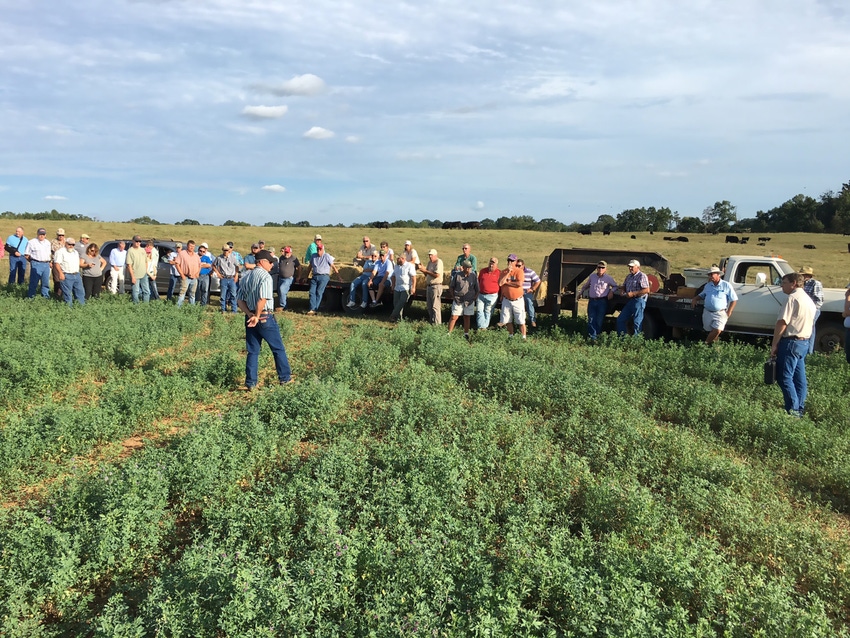Alfalfa tested with bermudagrass to increase forage quality, revenue
Potential for alfalfa acreage expansion in South is great.
October 9, 2017

South Carolina could soon see a return of the “queen of forages” to supplement bermudagrass, known as the “king of forages.” The “queen” is alfalfa, and Clemson researchers are working with South Carolina livestock producers to determine how to effectively incorporate alfalfa into forage crops, such as bermudagrass.
“Alfalfa is an excellent forage that can be successfully used in many types of livestock feeding programs,” Clemson extension forage specialist John Andrae said. “It is a versatile crop that can be used for pasture or as hay, silage or greenchop. Alfalfa also can play an important role in crop rotations because it fixes and supplies substantial amounts of organic nitrogen to subsequent crops and has numerous other positive effects on soil fertility, soil structure and soil health.”
Alfalfa is not a new crop in the southern U.S.; it has been grown in the region since the late 1800s. Alfalfa acreage increased in the South for several decades in the early 1900s. Then, with the arrival of the alfalfa weevil in the late 1950s and an abundant supply of inexpensive nitrogen fertilizer, alfalfa acreage fell sharply in the early 1960s and has remained low ever since then.
However, Andrae and his team are working with producers Neil and Gwen McPhail of Tokeena Farms in Seneca, S.C., and Kevin and Lydia Yon of Yon Family Farms in Ridge Spring, S.C., to bring alfalfa back to the top of the forage list.
They are working on a project that involves growing alfalfa in combination with existing stands of bermudagrass to increase forage quality as well as grow a supplemental feed and/or cash crop. This project is also receiving support and sponsorship by America’s Alfalfa under its GotBermudagrass? initiative. It includes 12 current on-farm demonstration plots across the southern “Bermudagrass Belt,” from North Carolina to Oklahoma.
McPhail has a 50-year-old stand of bermudagrass he uses for hay. After growing on the same land for 50 years, the bermudagrass stand was thinning, so McPhail was searching for a way to increase the quality of forages produced on the farm while reducing overall input costs.
To increase nitrogen in the soil, McPhail planted alfalfa on 16 acres of his bermudagrass crop.
“I’ve been pleased with it so far,” he said. “We’re seeing an increase in nitrogen in the soil, and overall it has proven to be a wise decision. Our livestock can graze on it when we’re not cutting and get some of the protein they need in their diets. It’s a versatile crop that is easy to maintain and use.”
Even though he is pleased with his alfalfa crop, McPhail said he would do one thing differently next time. “I’d plant 15 in. rows,” he said. “We planted on 7.5 in. rows, and the bermudagrass was suppressed more than I would like for it to be. So, we’re going to bigger rows next time.”
Research conducted at Clemson by Bill Stringer, professor emeritus, indicates that alfalfa can be successfully established in 8 in., 16 in. or 24 in. rows, with bermudagrass becoming more competitive as the row spacing increases. Wider rows decrease shading by the alfalfa. However, the impact of these wider rows on alfalfa stand life were not measured in the two-year study and are unknown.
“It’s a give-and-take situation,” McPhail said. “We’ll just have to work with it to find what works best for us.”
The Yons are similarly pleased with their alfalfa crop.
Kevin Yon noted that alfalfa shows "a lot of promise for growing high-quality forage and reducing producer costs, especially for purchased protein supplements and nitrogen fertilizer. Dependent upon the time of year, one species appears dominant over the other, but both seem to battle it out and maintain adequate amounts of each in the stand.”
The Yons are growing alfalfa on 35 acres of bermudagrass. Yon said he has found the relative feed value (RFV) to be “fantastic,” and his cattle seem to enjoy eating it. He also noted the importance of conducting soil tests prior to planting. RFV is used to compare the quality of legume and legume/grass hays and silages; a higher RFV indicates better forage quality.
“Conduct a soil test, and make sure pH (acidity or alkalinity) and other nutrients are at proper levels several months prior to planting to get the best results,” he said. “Make sure the soil type selected is conducive to growing alfalfa.”
Alfalfa grows best and sustains longer-lived stands when the soil pH is maintained at 6.5-6.8, Andrae said. Nitrogen fixation in the root nodules is reduced as pH decreases. Micronutrients like boron and molybdenum will be required in some areas.
Alfalfa has a high nutrient value, making it an ideal legume hay. Information from the U.S. Department of Agriculture shows that alfalfa contains between 15% and 22% crude protein as well as high amounts of 10 different vitamins. Because of its high nutrient value, McPhail said he is working with a livestock nutritionist to develop a hay mix of bermudagrass, alfalfa and barley for his herd.
Alfalfa hay is used as a feed primarily for dairy cows but also can be fed to horses, beef cattle, sheep and other farm animals. It is the fourth most widely grown crop in the U.S., with 26 million acres cut for hay at an average yield of 2.3 tons per acre and an estimated annual value of $11.7 billion. The record yield of one acre of alfalfa is 10 tons. Alfalfa can be a very productive crop, with high levels of biomass accumulation.
“The potential for alfalfa acreage expansion in the South is great,” Andrae said. “The demonstration plots we have at Tokeena Farm and Yon Family Farms prove that it can be successfully grown in the South.”
You May Also Like



